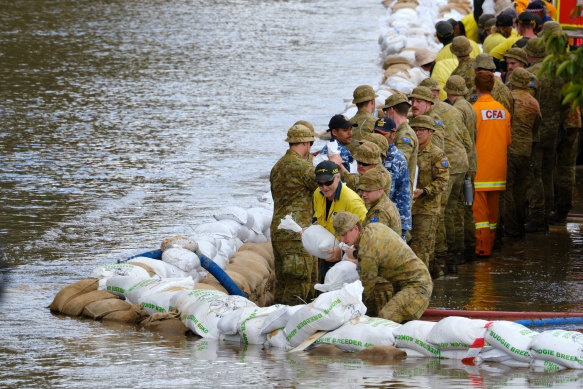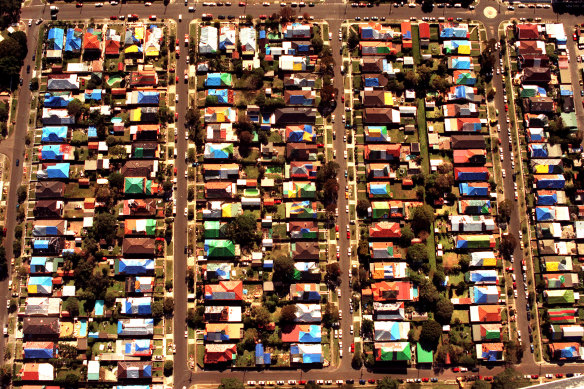This was published 1 year ago
‘Can’t wait until disaster’: Call for development bans, buybacks in high-risk areas
By Shane Wright
The insurance industry is calling for more funding to protect communities from natural disasters, bans on development in risky areas such as floodplains, and government buybacks of existing homes, amid warnings the cost of insurance will continue to soar.
As consumers start to ditch insurance under the weight of price increases of up to 30 per cent over the past year, the Insurance Council of Australia will on Wednesday release research showing the cost of rebuilding from natural disasters will put more strain on the nation’s population centres.

Floods that swept through Victoria caused more than $730 million in insurance losses last financial year.Credit: Erin Jonasson
The 2021-22 financial year was the worst in history for natural disaster-related insurance costs at $7.3 billion. The flooding of south-east Queensland and northern NSW alone cost more than $6 billion.
Last financial year, the insurance bill from natural disasters dropped sharply to $1.6 billion. The worst single event was the floods of October through to December that caused $736 million in insurance losses across Tasmania, NSW, Victoria and South Australia.
Insurance Council chief executive Andrew Hall said although the insurance costs of the past year were a fifth of those in 2021-22, the growing risk of extreme weather had not gone away.
“This new data shows that when – not if – extreme weather events strike large population centres in the future, we can expect them to have a greater impact and be more costly, making the case for risk mitigation even more pressing,” he said.
“We can’t wait until disaster strikes. We need to act now by investing more to make communities more resilient, reform land-use planning and building codes and, in some cases, move people and homes out of danger altogether.”
The cost of insurance is now growing at a much faster rate than overall inflation. Over the past year, overall insurance prices have jumped by 14.2 per cent, with many customers facing increases of between 20 and 30 per cent on particular policies.
Contributing to high-priced insurance has been a lift in the cost of rebuilding.
The report found that in today’s dollars, and accounting for changes in property values and construction processes, the hailstorm that hit Sydney in 1999 would have resulted in insured losses of $8.9 billion. At the time, the insured losses were $1.7 billion.
Cyclone Tracy, which caused $200 million of insured losses when it flattened Darwin in 1974, would in today’s dollars have created $7.4 billion in losses.
The council said all governments had to do more to reduce the price pressures on insurance and increase the ability of communities to withstand more intense natural disasters.
The federal government last year created the Disaster Ready Fund, which provides up to $200 million a year towards projects to improve resilience to or reduce the risk of future natural disasters.
Planned to operate for five years, its first round of funding provided support for flood levees, an improved pollen forecasting network for much of Australia, the protection of electricity networks in isolated regional communities and stormwater upgrades.

The 1999 hailstorm that hit Sydney would now cost insurers almost $9 billion.Credit: Robert Pearce
But the Insurance Council believes the funding needs to be indexed with inflation, so the real value of the fund is not reduced over time, and that it should be extended for a decade. It estimates this would cost the budget $2.5 billion over the next 10 years.
It is also urging all governments to consider disaster and climate risk in land-use planning and building standards, arguing for an end to development on floodplains.
More government buybacks of properties that were too difficult to protect from natural disasters had to be considered, it said, along with retrofitting of properties – such as elevating homes above expected floods.
Governments could also reduce price pressures by abandoning taxes on insurance, as recommended in the 2010 Henry tax paper. Outside the ACT, all states and territories impose stamp duty on insurance.
“In states and territories where stamp duty is charged on top of the GST, consumers are being double taxed on their insurance premiums,” the council argued.
“Consumers are being triple taxed on their premiums in the states like NSW that maintain emergency services levies. These taxes can drive up premiums by 20 to 40 per cent, not including the impact of GST.”
Cut through the noise of federal politics with news, views and expert analysis from Jacqueline Maley. Subscribers can sign up to our weekly Inside Politics newsletter here.